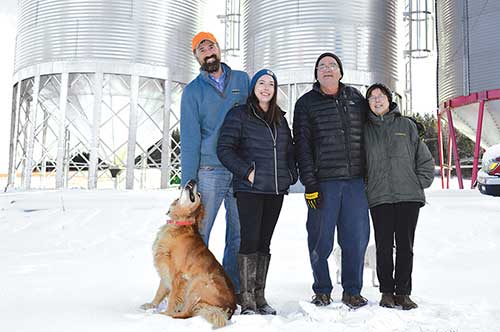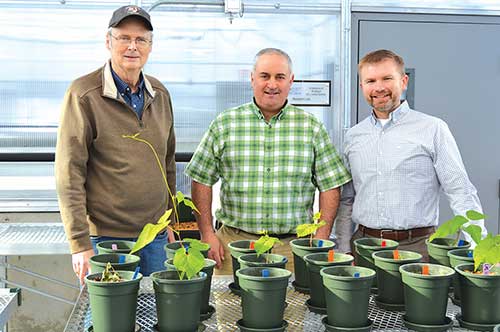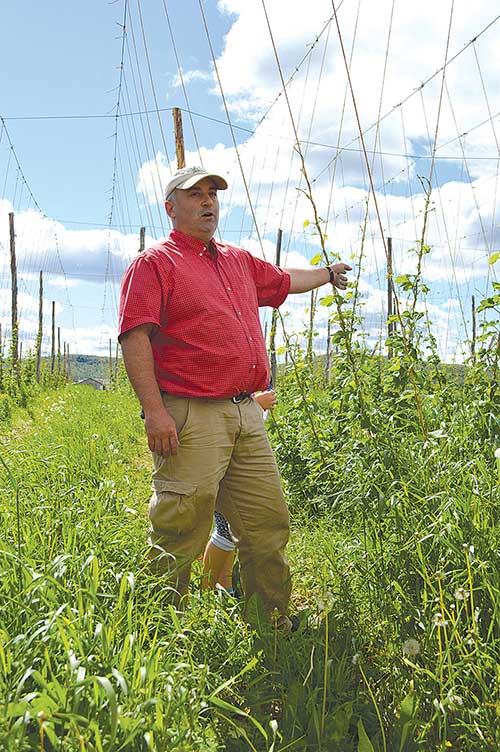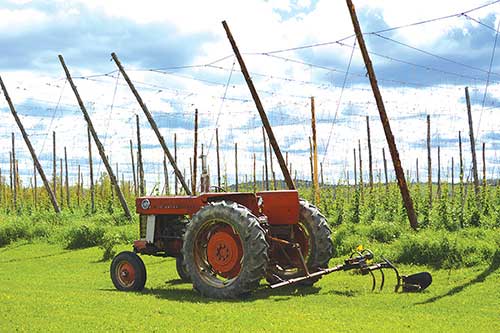 |
| Two generations cultivate Aurora Mills & Farm. From the left and standing in front of some of the new silos: Marcus Flewelling, Sara Williams Flewelling, Matt and Linda Williams. |
 |
| Making things grow at UMPI: from the left, Jim Dwyer, the Dr. Robert Vinton Akeley Chair of the Agricultural Science and Agribusiness program; Jason Johnston, dean of the College of Arts and Sciences (and co-owner of MOFGA-certified organic Aroostook Hops); and Noah Winslow, adjunct instructor of agricultural economics and agribusiness. |
 |
| Jason Johnston on his Aroostook Hops farm. |
 |
| Growing hops involves significant infrastructure. |
By Jean English and John Chartier
On a couple of snowy days last November, we took advantage of the off-season to visit a few enterprises that contribute to Aroostook County’s agricultural economy: Aurora Mills, Yost Farms and the University of Maine at Presque Isle (UMPI – where we also got a hops update). Here’s our report from Maine’s biggest county.
Steady Growth at Aurora Mills
Five years ago The MOF&G covered Aurora Mills & Farm LLC in Linneus, Maine, near Houlton, where Matt Williams and his daughter Sara Williams Flewelling were growing MOFGA-certified organic grains on some 210 acres. They also processed grain from contracted growers and combined grain for various growers.
Sara had returned to the farm in 2013 after working as a landscape designer in Washington, D.C. She and Matt were growing wheat, spelt, peas, oats, clover, buckwheat and garlic on the farm that Matt and his wife, Linda, own. At the time Aurora was probably the third largest organic grain grower in Maine, possibly the largest organic wheat grower and probably the largest processor of all-Maine organic grain.
Adding Land
Since then, says Sara, she and her husband, Marcus Flewelling, bought a nearby farm where they now grow 90 acres of organic grain. They are renting and transitioning the farm next to it, which will be certified organic this year after being in clover for three years. “We’re slowly increasing acreage and trying to figure out how to bring on at least 25 acres per year,” says Sara. She and Marcus also added to their family, with two young children.
Adding Infrastructure and Income
Aurora Mills has added storage and drying capacity. Matt describes the “rolling” nature of the enterprise: “Resources go to increase farming and then to increase milling efficiency. The two can never be separated.” They added a grain dryer out of necessity, due to multiple cold, wet falls. And they upgraded to a John Deere 9550 combine with a 25-foot header. “We hope it will help us have less volunteer buckwheat because [the seed] is not hitting the ground,” says Matt.
They continue to add silos, and they hope to build a new processing facility offsite over the next five years so that they can continue to grow and meet their customers’ needs.
“Sarah’s made a huge effect,” says Matt. “Our equipment is getting better, and we intend to upgrade when we can afford it.”
In fact sales have quadrupled since she returned, says Sara – but even the current acreage is not enough. “When you get a customer,” says Matt, “you want to keep that customer going. It’s hard to get a new one” without growing more grain.
“Our customer roster has grown the same way as our farming: sustainably,” says Sara. “It’s easy to sell: People like our story, it’s multigenerational, and we are authentic.” In 2020 Matt and Sara were among 50 Mainers listed as “creating a bright future for the state” in Maine magazine.
The demand for organic grain is growing, Sara continues. “I hope plant protein catches on. College students want to know where their food comes from. They were raised on it. People love that crusty, hearty bread now. We could grow double the amount of wheat and I could sell it all easily, but it’s hard to grow organically. That’s why we keep growing the farm.”
She adds that margins are small for grain growing, so growers need more than a couple of hundred acres to make enough money.
Tweaking Crops and Rotations
Aurora is milling wheat, oats, peas, soybeans, rye and buckwheat, retailing most of the grains and milling some for other businesses, such as wheat for Borealis Breads and oats for Allagash Brewing.
“It’s nice to find partners who share the same values that we do – like Allagash and Borealis Breads,” says Sara.
“We look for the integrity in our customer to match our integrity,” adds Matt.
Matt notes that wheat is very dependent on mycorrhizae to break down and move nutrients to plants, much more so than oats. For that and other reasons, “we don’t use organic pesticides [including herbicides] at all.” Farmers who use fungicides, he says, have to use more fertilizer and water because fungicides kill mycorrhizae. “The system isn’t sustainable,” says Matt.
They continue to finesse their rotations and cleaning operations to deal with volunteer buckwheat or vetch seed in their grain crops and to deal with climate change. Their general rotation goes from cereals to a legume such as field peas, and then to buckwheat.
Winter rye has not grown well for them because of freeze and thaw cycles, says Matt. “It’s probably related to climate change. For the last three or four years, we’ve had warm January rain followed immediately by a sub-zero front. You get a huge ice sheet under the snow. So we’re coming to depend more on spring crops.
“Climate change is a threat to agriculture particularly,” he continues, “because you’re not going to be able to do it the way your grandfather or even your father did it. We’ll see how our friends in the Midwest do if wet springs become a constant.”
People know they’ll eventually have to eat less meat, Sara says, and Matt recalls a recent conference attended by people in charge of feeding students at Cornell University. “They’re aware of it. What’s driving that is climate change and the carbon footprint of food.” He says the food service people and the Cornell students communicate well. “It is becoming huge. Those students want to know what they’re eating and where it’s coming from. Cornell now has a local zone that is 350 miles around it. Move that to Harvard, MIT … That generation is going to be running this country.”
The Aurora farmers had limited success in using their red clover rotation crop for salable clover seed – first due to combine issues, which the 9500 solved, and then due to rain, which caused their clover seed to germinate before they could get it into storage. They tried soybeans, but the corn seed maggot reduced yields below the economic threshold. Now they’re trying crimson clover – an annual that should die over winter, enabling no-till planting in spring. “We’re going to try to move toward no-till as much as we can,” says Sara. Crimson clover, notes Matt, should fix more nitrogen than red clover, and the seed costs about one-third as much.
“We’re about long rotations,” says Sara, “but until the market catches up, we use some shorter ones. There’s a market for organic soybeans if we can get them to work.”
Field peas, she continues, did well in 2019 but lacked a food grade market. Matt says he was impressed that the canopy closed over, weeds were pretty nonexistent, yield was good and the peas combined easily. They came off at the end of August, after the first wheat harvest.
“Our biggest problem is grass, our most significant weed,” adds Matt. “Conventional growers freak out with mustard or kale. To me that’s not a real competitive weed. Wheat will have done what it needed to – tiller, etc. – by the time the mustard plant is up, and it’s not very deep rooted.”
Birds and Bees
Also new on the farm: “a million bees,” says Sara. The “bee whisperer” (Peter Cowin of Hampden, Maine) brings his hives to their farm to make honey. And this year, with funding help from the Natural Resources Conservation Service Environmental Quality Incentives Program, they’ll plant 5 acres of pollinator habitat on Matt and Linda’s farm and another 5 acres on Marcus and Sara’s farm where the ground is too wet to cultivate. Matt says he’s also open, where appropriate, to putting in hedgerows to support pollinators and other beneficials, particularly on roadside frontage. He says hedgerows compete better with grass than do herbaceous plants. Hedgerows also create a height barrier against potential pesticide drift. To meet organic certification standards, “we need a 100-foot buffer anywhere where there’s potential for drift,” says Matt.
Thanks to their wildlife-friendly farmscape, “we have an amazing amount of wasps, in addition to bees,” he says. “Because we don’t use any pesticides, we have a higher songbird population. Between the songbirds and the wasps, we didn’t have any cluster flies this year, or ladybird beetles that were always getting into the house. The wasps work the side of the building where the flies come.”
Succession Planning
Just as Matt and Sara often finish one another’s sentences, they and their spouses are making succession plans for the farm.
“It’s a tough thing to do,” says Matt.
“To let go,” Sara finishes.
Matt, now 75, says he’ll keep going as long as he can. “I enjoy trying to solve the problems about the rotation.” Meanwhile they are looking for a farm manager with mechanical ability and an organic orientation to train under Matt.
Youthful Energy and Risk Taking at Yost Farms
Some 40 miles north of Linneus and almost on the New Brunswick border, Tyler and Tristan Yost grow grains and more on Yost Farms in Blaine. Originally from Mississippi, the brothers moved to Maine when Tyler was 12. They had a garden and were interested in agriculture from a young age. Both are now married and have three young children each.
They started their own farming enterprise after working for a local potato farmer. “When I was 18,” says Tyler, “I rented 20 acres of ground, borrowed the farmer’s equipment and started growing crops. The next year my brother joined me. We had about 40 acres then. We tried to pick up more ground each year, largely focused on grains – conventional at that point.”
They started with soybeans, selling to a company in New Brunswick that ships up the Saint Lawrence Seaway.
Seeking more ground to rent, they looked for land coming out of the Conservation Reserve Program. “We got up to about 200 acres over five or six years that way,” says Tyler. “Then commodity prices started dropping.” Their soybeans had been doing fairly well without rotations until disease issues started cropping up, and “then things started falling apart. So we planted our first organic field on land that hadn’t been farmed, so there was no transition period. That was probably six years or so ago. We were scared! We were used to using chemicals. We thought the weeds were going to take over. We were pleasantly surprised. There were some weeds, but they weren’t too bad.”
They still plant some conventional crops to meet existing customers’ needs but have been adding more organic fields because the economics are better. They started with oats, then tried emmer, “with not very good results,” says Tyler. Then they considered growing crops that had more than one use so that if they didn’t make food grade, they would at least make feed. “Emmer can be a feed grain, but the feed markets don’t know it,” Tyler explains, “so you don’t get the value out of it. It took me two years to sell the organic emmer as feed.”
Two years ago they mixed their first organic feed ration of barley, wheat and minerals for Aaron Beachy of MOFGA-certified organic BB Farm in Hodgdon, Maine. “It’s worked for him. We’ve picked up customers for organic since then: Misty Brook in Albion and a few others.”
Now the Yosts are adding Cornish Cross chickens to sell to MOFGA-certified organic Tide Mill Farm, and they’re growing and grinding their own grains for those birds. As we spoke with Tyler in November, he was awaiting the first chicks and putting the finishing touches on the 40-by-68-foot facility that he and his brother designed and built for the project. Baby chicks will be delivered every three weeks. The building is divided into three rooms, and the animals will be moved from one room to the next as they grow. Fans provide ventilation, and doors open so that the chicks have outside access in warm weather.
Tyler and Tristan now farm a little over 500 acres of grain – about 30 to 40 percent of it organic. “The organic side is growing,” says Tyler. “We’re keeping the conventional where it is. We have customers we’re growing conventional for, so we’re just meeting their needs. We’re not pushing that so much, but the organic side seems like there’s plenty of potential for growth – but there are more challenges with weeds, diseases, rotations. Our number one challenge is wild radish and lambsquarters. We have fields that are pretty bad, and we’re trying to find ways to deal with them economically. The potential for growth is there, but I don’t want to grow faster than I know what we’re doing. We’re probably already pushing that. [Organic] takes more management and labor.”
The brothers and one full-time worker, Levi, do all the farm work. None have off-farm jobs. “We’re all here 50 to 80 hours a week,” says Tyler. “We’re here for the long haul, unless something changes.”
A trucking company hauls their grain to customers’ farms. “If people can handle tote bags, we can move that fairly efficiently around the state,” says Tyler. “But a lot of people don’t have a big enough tractor to get [totes] off the truck, or they have grain bins. You need a tractor that can lift a ton, or a forklift. I can get a tote bag anywhere in the state for $60.”
In addition to barley and wheat, they grew some peas and a little corn and soybeans in 2019. Some wheat goes to Aurora Mills; some to Maine Grains. “All the rest we grind into feed. If it’s not food [grade], it probably doesn’t leave here as a whole grain. And now some will leave as meat.”
They expect their facility to produce about 30 tons per year of chicken litter, which they’ll spread on up to 40 acres of land. That plus peas or soybeans will add nitrogen to the soil. “Finding nitrogen inputs was an incentive” for the poultry business, says Tyler.
While chicks are available only every three weeks, Tide Mill needs finished birds every week. “There are challenges,” says Tyler.
New Greenhouse and New Ag Major at UMPI
In September 2019 the University of Maine at Presque Isle (UMPI) dedicated its new Zillman Family Greenhouse – a state-of-the-art teaching and research space with year-round opportunities. The $935,000, 2,400-square-foot structure features a teaching classroom, two climate-controlled research labs and a faculty office for Jim Dwyer, the Dr. Robert Vinton Akeley Chair of the Agricultural Science and Agribusiness program. Dr. Don Zillman, UMPI president from 2006 to 2012, and his wife, Linda Zillman, provided the first gift for the greenhouse. Subsequent grants and gifts completed the funding.
During the dedication, Dwyer and UMPI’s ag students did a ceremonial planting in pots of Kennebec potatoes, a variety created by Dr. Robert Akeley, in the greenhouse. Akeley was a Presque Isle native, father of donor Mary Akeley Smith, internationally known potato breeder and leader of the USDA National Potato Breeding Program.
In addition to supporting the greenhouse, funds from Mary Akeley Smith enabled purchase of a new John Deere tractor and Gator for ag-related programming and composting efforts and a new DJI Inspire II drone for precision ag and mapping work.
The new greenhouse “is great for students in the ag program to demonstrate agricultural practices and plant growth habits through the school year,” Dwyer told us. Currently about 25 students are in the ag program. In addition, students from SAD 1 and from Caribou High School can earn college credits at UMPI while in high school.
Jason Johnston, an ecologist and dean of the College of Arts and Sciences (and co-owner of MOFGA-certified organic Aroostook Hops), explains that UMPI started its sustainable agriculture program within the environmental sciences department in 2014, and that plus a survey of local people led to the new, additional degree in agricultural science and agribusiness. The new degree focuses more on science, agronomy and agribusiness.
“Connections we’ve made locally with Cooperative Extension and with the Aroostook Research Farm, and researching plant biomass, generated a lot of conversations and connections and understanding of who we had locally for capacity. We’re in the middle of ag land. I reached out to John Rebar [of UMaine Cooperative Extension] and said we’d like to start a program but would have to share faculty positions. So we had the first university system joint appointment with him. Then we added another position, and then the endowed chair.
“It’s really a dense major,” says Johnston, “because as a farmer you have to know everything: managing people, managing money, managing data, all of the basic ag science and technology.
We want to make sure we’re relevant. Our goal is 15 graduates from the ag business program per year.”
Students in the new major have a practical learning experience requirement, which can be an internship, an independent study or GIS training. Dwyer notes that many UMPI students actively farm already on their family farms. “This makes for great conversations during class.”
Dwyer worked for UMaine Cooperative Extension for 38 years before filling the endowed chair at UMPI. Among his courses are operations and safety, introduction to agriculture and crops, introduction to entomology and introduction to plant pathology.
The ag program should help meet the needs of McCain Foods and other area companies that are seeking trained employees. “It’s harder and harder to find people with that expertise,” says Dwyer. “We hope we’ll be able to fill that need – and encourage our young people to stay here.”
Noah Winslow, an adjunct instructor of agricultural economics and agribusiness at UMPI, teaches the program’s agribusiness courses. “What makes the program unique,” he says, “is that it’s a solid ag program – greenhouse ag, production systems, botany – but also three or four agribusiness-specific classes. I think it’s unique in Maine to have such in-depth agricultural science plus such exposure to agribusiness.”
Winslow, in fact, found that his students have far more interest in farm-level production agriculture than he had anticipated. “I recalibrated parts of my course to take that into account.”
When Winslow brought a guest speaker who sells farm equipment throughout New England to his class, “he was putting feelers out for possible candidates to hire in the future. There are a lot of opportunities in this industry. There are so many synergies – the location of this campus, this greenhouse; the major agricultural growing area is key to the future here.”
One important area of focus is managing agricultural data, says Winslow. “GIS/GPS-guided machines and precision agriculture are so important for information management now. Irrigation systems can run from your smart phone. You can control ventilation systems from your home computer.” UMPI got a large U.S. Department of Education Title III grant for a computer science program, and one course proposed for that program is management of agricultural and natural resource data.
Dwyer notes that “a tremendous amount is riding on that information – for example, operating irrigation systems or managing storage from smart phones.” Ensuring the security of that information is important, he adds.
In 2020 UMPI was named one of five Most Innovative Schools for Regional Colleges in the North in the U.S. News and World Report Best Colleges list. It was also named among the 30 Best Regional Colleges in the North, the top 20 Public Schools in the North, the top 15 Regional Colleges in the North for graduates with least debt and the top 25 Regional Colleges in the North for Social Mobility. About 1,200 students attend UMPI, most full-time.
Jumping Over to Hops
We took advantage of our visit to ask Johnston about Aroostook Hops, which he and his wife, Krista Delahunty, and their children raise. He says they are doing well. “We sell to 10 or 12 breweries, almost exclusively in Maine.” That includes Allagash, which recently brewed its first organic beer.
“We need to grow more,” says Johnston, “but we also need to expand our ability to harvest and process. Labor is a constant issue during harvest. If we can get a new used harvester, that will reduce labor and increase our harvest ability about three-fold.
“There is definitely potential to grow the industry here,” he continues. “For us it’s a matter of balancing off-farm work, family and farming.”
For weed control, tilling up to the perennial plants would damage their roots, and straw mulch works for the first year or two but is expensive to buy and apply and is impractical on a large scale. So he tried running sheep through the hops rows to control vegetation, to strip the lower part of the bines (the long, climbing stems) and to help control downy mildew. The idea is that “the sheep prune the plants up as high as they can get on their hind legs. They prefer hops by far to other vegetation. Unlike goats, they leave the stems alone.”
However, the sheep farmer brought four rams and eight ewes, says Jonhston. “The rams were rough on the plants. If they got stuck they would keep going forward. They broke about 100 strings” on the hops trellises.
Sheep also promote grass growth because grass recovers better than dicots such as goldenrod. Johnston had clover between his rows for a few years before grasses came in. He would mow it twice, directing clover clippings onto hops rows to add a little nitrogen. He’s also planted some buckwheat to attract beneficial insects.
Johnston says that 12 to 20 years is probably the practical life of a hops planting, depending on the variety and shifts in marketing and whether the trellis needs to be reestablished. Some local hops plantings from the ‘30s still have feral plants.
Hops are challenging in terms of yield, pests and diseases, he adds. Some varieties are more susceptible than others to downy mildew, and two-spotted spider mites were an issue two summers ago since mites love dry, hot weather. Overhead irrigation might help, but that’s big and difficult to move – and may contribute to fungal disease. And “so much is unknown about controlling insects, especially in hops,” Johnston concludes. Maybe that’s a research project for UMPI students.
